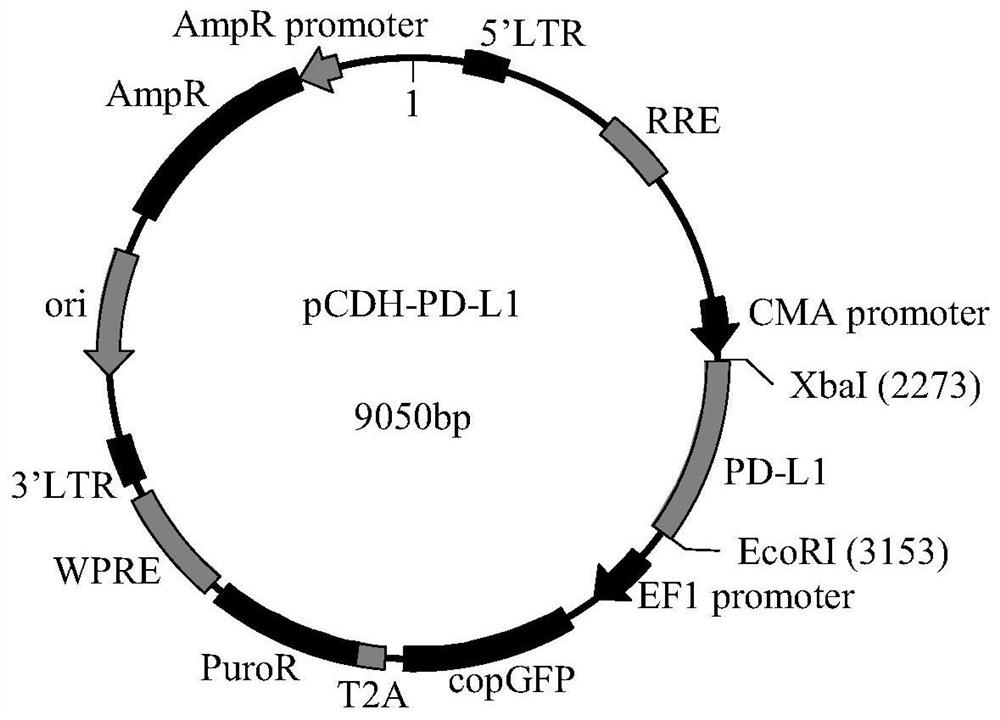Mesenchymal stem cell strain for overexpression of PD-L1 gene as well as a construction method and application of mesenchymal stem cell strain
A PD-L1, stem cell technology, applied in the field of biomedicine, can solve the problems of insignificant treatment effect, high disease recurrence rate, treatment of arthritis and other problems, achieve significant curative effect, inhibit inflammatory response, and reduce the degree of joint damage.
- Summary
- Abstract
- Description
- Claims
- Application Information
AI Technical Summary
Problems solved by technology
Method used
Image
Examples
Embodiment 1
[0033] Preparation and Identification of Mesenchymal Stem Cells
[0034] 1. Mesenchymal stem cell culture
[0035] (1) Take 10-15ml of bone marrow (or 3-5ml of bone marrow from the ribs of normal people), add 100u heparin to each ml of bone marrow, mix thoroughly, store in a refrigerator at 4°C, and separate bone marrow mononuclear cells within 24 hours ( MNC). First add an equal amount of PBS or Hanks solution (or culture medium) to the bone marrow and mix well, then slowly add the diluted bone marrow to the surface of the ficoll liquid (density 1.077) at the ratio of 1 part of lymphocyte separation solution to 2 parts of diluted bone marrow, and horizontally centrifuge Centrifuge at 500g (2000r / min) for 25-30 minutes at 20°C. After the MNCs taken out from the interface were washed 2-3 times with PBS, an appropriate amount of culture medium was added for counting. Cell number up to 10 6 ~10 7 After / ml, the primary culture was carried out, and 5×10 6 / ml concentration i...
Embodiment 2
[0044] Construction of bone marrow mesenchymal stem cell line PD-L1-MSC overexpressing PD-L1 gene
[0045] 1. Design and amplification of PD-L1 gene PCR primers
[0046] The mouse PD-L1 gene sequence was queried in NCBI, the nucleotide sequence information is shown in SEQ ID NO.1, and the amino acid sequence information is shown in SEQ ID NO.8. PD-L1 primers were designed using Primer5.0 software.
[0047] Upstream primer PD-L1-F: tctagaATGAGGATATTTGCTGGCATT (SEQ ID NO: 2)
[0048] Downstream primer PD-L1-R: gaattcTTACGTCTCCTCGAATTGTG (SEQ ID NO: 3)
[0049] The mouse PD-L1 gene was amplified by PCR using the mouse lung cDNA as a template and using the primers designed above.
[0050] 2. Lentivirus packaging pCDH-PD-L1 plasmid
[0051] The PD-L1 sequence was constructed on the lentiviral vector pCDH-CMV-MCS-EF1-copGFP-T2A-Puro to obtain a lentiviral plasmid expressing pCDH-PD-L1.
[0052] Construction method: The above PCR product was connected to a T vector for sequencin...
Embodiment 3
[0056] Identification of PD-L1 gene expression in bone marrow mesenchymal stem cell lines transfected
[0057] 1. Fluorescence microscopy to observe the efficiency of lentivirus pCDH-PD-L1 transfection bone marrow stem cells
[0058] 24 hours after the lentivirus pCDH-PD-L1 transfected the bone marrow stem cells, the original medium was replaced with fresh complete medium, the culture was continued, and observed under a fluorescent inverted microscope 48 hours later. The result is as Figure 4 As shown, the transfection efficiency of PD-L1 was found to be greater than 90%.
[0059] 2. RT-PCR method to analyze the expression of PD-L1 gene
[0060] The RNA of bone marrow stem cells transfected with pCDH-PD-L1 was extracted by Trizol method, and reverse transcribed into cDNA. At the same time, the RNA of the stem cells transfected with the pCDH-CMV-MCS-EF1-copGFP-T2A-Puro empty vector was extracted, reverse-transcribed into cDNA, and a control experiment was performed. Primer...
PUM
 Login to View More
Login to View More Abstract
Description
Claims
Application Information
 Login to View More
Login to View More - R&D Engineer
- R&D Manager
- IP Professional
- Industry Leading Data Capabilities
- Powerful AI technology
- Patent DNA Extraction
Browse by: Latest US Patents, China's latest patents, Technical Efficacy Thesaurus, Application Domain, Technology Topic, Popular Technical Reports.
© 2024 PatSnap. All rights reserved.Legal|Privacy policy|Modern Slavery Act Transparency Statement|Sitemap|About US| Contact US: help@patsnap.com










